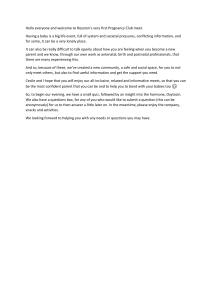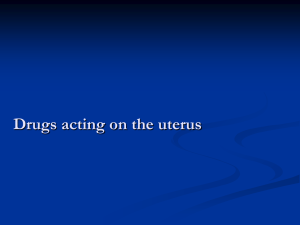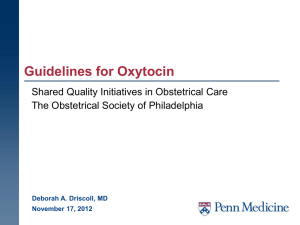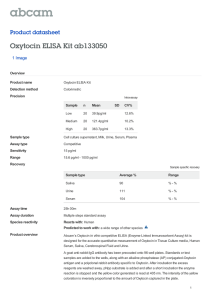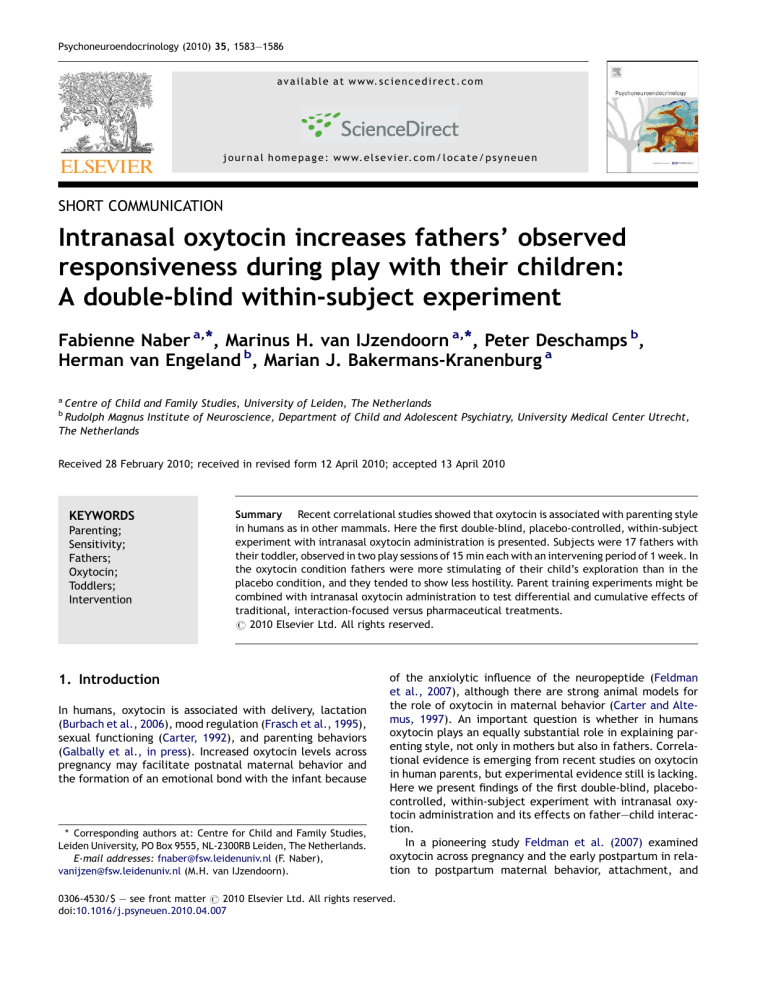
Psychoneuroendocrinology (2010) 35, 1583—1586 a v a i l a b l e a t w w w. s c i e n c e d i r e c t . c o m j o u r n a l h o m e p a g e : w w w. e l s e v i e r. c o m / l o c a t e / p s y n e u e n SHORT COMMUNICATION Intranasal oxytocin increases fathers’ observed responsiveness during play with their children: A double-blind within-subject experiment Fabienne Naber a,*, Marinus H. van IJzendoorn a,*, Peter Deschamps b, Herman van Engeland b, Marian J. Bakermans-Kranenburg a a Centre of Child and Family Studies, University of Leiden, The Netherlands Rudolph Magnus Institute of Neuroscience, Department of Child and Adolescent Psychiatry, University Medical Center Utrecht, The Netherlands b Received 28 February 2010; received in revised form 12 April 2010; accepted 13 April 2010 KEYWORDS Parenting; Sensitivity; Fathers; Oxytocin; Toddlers; Intervention Summary Recent correlational studies showed that oxytocin is associated with parenting style in humans as in other mammals. Here the first double-blind, placebo-controlled, within-subject experiment with intranasal oxytocin administration is presented. Subjects were 17 fathers with their toddler, observed in two play sessions of 15 min each with an intervening period of 1 week. In the oxytocin condition fathers were more stimulating of their child’s exploration than in the placebo condition, and they tended to show less hostility. Parent training experiments might be combined with intranasal oxytocin administration to test differential and cumulative effects of traditional, interaction-focused versus pharmaceutical treatments. # 2010 Elsevier Ltd. All rights reserved. 1. Introduction In humans, oxytocin is associated with delivery, lactation (Burbach et al., 2006), mood regulation (Frasch et al., 1995), sexual functioning (Carter, 1992), and parenting behaviors (Galbally et al., in press). Increased oxytocin levels across pregnancy may facilitate postnatal maternal behavior and the formation of an emotional bond with the infant because * Corresponding authors at: Centre for Child and Family Studies, Leiden University, PO Box 9555, NL-2300RB Leiden, The Netherlands. E-mail addresses: fnaber@fsw.leidenuniv.nl (F. Naber), vanijzen@fsw.leidenuniv.nl (M.H. van IJzendoorn). of the anxiolytic influence of the neuropeptide (Feldman et al., 2007), although there are strong animal models for the role of oxytocin in maternal behavior (Carter and Altemus, 1997). An important question is whether in humans oxytocin plays an equally substantial role in explaining parenting style, not only in mothers but also in fathers. Correlational evidence is emerging from recent studies on oxytocin in human parents, but experimental evidence still is lacking. Here we present findings of the first double-blind, placebocontrolled, within-subject experiment with intranasal oxytocin administration and its effects on father—child interaction. In a pioneering study Feldman et al. (2007) examined oxytocin across pregnancy and the early postpartum in relation to postpartum maternal behavior, attachment, and 0306-4530/$ — see front matter # 2010 Elsevier Ltd. All rights reserved. doi:10.1016/j.psyneuen.2010.04.007 1584 parental cognitions. This study was the first to report a significant association between elevated oxytocin levels and more sensitive maternal interactions with the infant. They found no association between oxytocin levels and any demographic factor or with breast feeding. In a second study Strathearn et al. (2009) observed mothers of 7-month-old infants interacting with their baby during a 5-min free play session and assessed their serum oxytocin levels before and after the interaction. Oxytocin levels of mothers with secure representations of their own childhood attachment experiences were more elevated after interacting with their infant compared to insecure-avoidant mothers. Feldman et al. (2010) studied oxytocin in mothers and fathers engaged in a 15-min play-and-contact interaction session with their 4—6-month-old infants. Baseline levels of plasma and salivary oxytocin were strongly associated, and appeared to be similar in mothers and fathers. Oxytocin levels were associated with parent-specific modes of interaction. Whereas maternal oxytocin levels were positively associated with affectionate touch, paternal oxytocin was uniquely associated with stimulatory contact, but not affectionate touch. Furthermore, highly affectionate mothers showed oxytocin increases following interactions with their infants whereas similar increases were observed in highly stimulating fathers. In the current experiment we test the hypothesis that oxytocin is causally related to fathers’ playful interactions with their children. Intranasal administration of oxytocin is expected to lead to increased paternal responsiveness to the child during play since oxytocin enhances sensitivity for the child’s cues (Feldman et al., 2007). In line with Feldman et al.’s (2010) finding we expect fathers to show in particular more encouraging and stimulating interactive behavior in the oxytocin condition compared to the placebo condition. 2. Method 2.1. Procedure Seventeen fathers (mean age 37.9 years, SD = 3.80, range 31—45) participated in the double-blind, placebo-controlled, within-subject design. All participants received once intranasal oxytocin and once a placebo to investigate the effects of oxytocin on the interaction with their child. Neither the experimenter nor the participant knew during which visit the participant received oxytocin; roughly half of them received oxytocin during the first visit. The study protocol was approved by the ethics committee of the University Medical Center Utrecht. All fathers gave written informed consent before their participation. Written informed consent for the children was given by both parents. The participants were all healthy volunteers with at least one child in the age between 1.5 and 5 years of age (mean age 33.8 months, SD = 11.8). A single dose of 24 IU oxytocin nasal spray (Syntocinon spray, Novartis, Basal, Switzerland) or placebo, nasal spray without oxytocin, was administered intranasally 45 min before the start of the play session. In the 45 min before the play session the fathers performed (computer) tasks without their child. Participants underwent both the oxytocin and the placebo conditions with an interval of 1 week in a balanced withinsubject design. F. Naber et al. The play sessions lasted 15 min and were slightly different on both occasions. During the first visit they played a game in which father and child in turn placed tiny dolls on a rocking tower until the tower fell over, they played with a doctor-kit, and they made a large floor-puzzle. During the second visit, father and child were invited to build a tower of magnets, after which they played with a doll and a tea-set, and then painted a colouring picture. Fathers were instructed to play with their child as they usually did. Both sessions took place at home and were videotaped for later analysis. 2.2. Measures Paternal responsiveness. The Emotional Availability Scales (EAS; Biringen et al., 1998) were used to assess paternal sensitivity. The scales consist of four subscales for parenting behavior; sensitivity, structuring, non-intrusiveness, and non-hostility. Sensitivity of the parent was coded on a 9-point rating scale. High sensitivity refers to a parent’s responsiveness to the child’s emotional signals and communication in a flexible way. A parent was coded insensitive when little interaction between parent and child was demonstrated. Parental structuring was coded on a 5-point rating scale. It refers to the parental ability to support learning and exploration with respect for the child’s autonomy. When a parent does not offer structure or does not involve the child in play, low scores on structuring are assigned. High scores for structuring are assigned when parents not only respond to the child’s verbal cues, but also to non-verbal cues. Non-intrusiveness was coded on a 5-point rating scale with high scores for parents who are available for the child without being interfering, overprotective, or overwhelming. An intrusive parent controls the interaction and shows lack of respect for the child’s autonomy. Non-hostility was also coded on a 5-point rating scale. Parents received high scores when no negative emotions (e.g. impatience, discontent, rolling the eyes, etc.) were shown. The EAS also includes rating scales for child responsiveness and involvement. Responsiveness is rated as the intensity and the quality of the child’s reactions to the parent’s bids, while involvement reflects the child’s attempts to engage the parent in the interaction. Child responsiveness and child involvement were coded on 7-point rating scales. The play sessions were coded by two trained observers, who were unaware of the condition of the fathers (oxytocin or placebo). Intercoder reliability for 11 randomly chosen sessions was excellent (mean intra-class correlation r = .95). We used one observer’s ratings of all first visit play sessions and the other’s ratings of all second visit play sessions. 3. Results Two preliminary multivariate repeated measures analyses of variance on the four parenting scales were performed with order of oxytocin administration (first or second session) and gender of child as respective between-subjects factors. No effects were detected for order, F(1,15) = 2.18, p = .13, nor for gender F(1,15) = 0.73, p = .59. A multivariate repeated measures analysis of variance on the four parenting scales with oxytocin or placebo as a within-subject factor was Intranasal oxytocin increases fathers’ observed responsiveness during play Fig. 1 Dimensions of parenting and child behavior in the placebo and oxytocin conditions (mean, SE). Notes: *p < .05, y p < .10; dimensions rescaled (1—9) for ease of interpretation. performed to examine the effect of oxytocin administration on parenting behavior. We found a significant difference between placebo and oxytocin condition, F(4,13) = 3.17, p .05. Subsequent univariate analyses showed a significant difference for responsive structuring, with higher scores in the oxytocin condition (M = 3.96, SD = 0.46) than in the placebo condition (M = 3.60, SD = 0.59), F(1,16) = 7.73, p = .01, h2 = .33. In the oxytocin condition fathers also tended to show less hostility than in the placebo condition (oxytocin M = 4.44, SD = 0.56, placebo M = 4.19, SD = 0.51), F(1,16) = 3.09, p < .10, h2 = .16. No significant differences were detected for sensitivity (oxytocin M = 6.37, SD = 1.23, placebo M = 6.12, SD = 1.29), F(1,16) = 0.57, p = .46, and for non-intrusiveness (oxytocin M = 3.60, SD = 0.84, placebo M = 3.53, SD = 0.80), F(1,16) = 0.10, p = .76. In a multivariate repeated measures analysis of variance on child responsiveness and child involvement no significant condition effect was found for child responsiveness (oxytocin M = 5.74, SD = 0.88, placebo M = 5.69, SD = 0.68), nor for child involvement (oxytocin M = 5.76, SD = 1.00, placebo M = 5.62, SD = 0.78), F(2,15) = 0.35, p = .71, h2 = .05. In Fig. 1 the results are summarized. 4. Discussion This is the first experimental study showing that intranasal oxytocin administration leads to more responsive interactions of fathers with their child during play. In the oxytocin condition fathers stimulated their child’s exploration and autonomy in a more optimal way than in the placebo condition. The fathers also tended to show less hostility to the child in the oxytocin condition, showing less impatience, discontent, and behaviors of that kind. Our experimental finding complements the Feldman et al. (2010) study results indicating that fathers who were asked to engage in a ‘‘play-and touch’’ interaction session with their infant showed elevated oxytocin levels after the session when they had been more stimulating to their child; a similar effect was absent in fathers showing higher levels of affectionate touch. In our experiment, intranasal oxytocin administration led to more stimulating play but not to elevated levels of affectionate, sensitive interactions during play — as 1585 might have been the case for mothers. This is an intriguing example of the transactional nature of parenting and the neuroendocrine system, with changes in oxytocin levels inducing changes in responsive parenting, and specific parenting behaviors leading to changes in oxytocin levels. Strathearn et al. (2009) showed that maternal oxytocin responses to free play interactions with their infants were strongly associated with activation of hypothalamus/pituitary region and the right ventral striatum in response to neutral own-infant face cues. These brain regions are considered to be involved in oxytocinergic and dopamine-associated reward processing. The authors speculate that oxytocin may be one mechanism by which socially relevant cues activate dopaminergic pathways and thus reinforce behavior. Parents who are more responsive when interacting with their infants may produce more oxytocin, which in turn may increase the experience of reward and contribute to the parents’ ability to provide responsive care. The anxiolytic role of oxytocin in the regulation of mood and social stress (Heinrichs et al., 2003) may also enhance empathic concern, trust, and prosocial behavior (Kosfeld et al., 2005; Zak et al., 2007), and decrease feelings of hostility that would interfere with synchronous dyadic interactions. Some limitations of the current study should be noted. First, due to our small sample the multivariate repeated measures analysis was just significant, but the effect sizes were substantial according to conventional criteria. The experiment should be replicated in larger samples and in parents with lower base-line responsiveness. The current sample scored rather high on the four dimensions of the EAS, and a ceiling effect may have prohibited even stronger effects of oxytocin administration. Second, intranasal administration of oxytocin has been used successfully in previous studies (e.g. Heinrichs et al., 2003; Kosfeld et al., 2005; Domes et al., 2007), but it is still unclear how it affects oxytocin levels in the brain, although it is assumed that neuropeptides like oxytocin have a passage through the blood brain barrier (Insel and Young, 2000). In future studies experimental administration of oxytocin may be examined in relation to the role of the oxytocin receptor gene (OXTR). In a previous study we showed an association between maternal sensitive behavior to their infant and OXTR in combination with the serotonin transporter (5-HTT) gene (Bakermans-Kranenburg and Van IJzendoorn, 2008). Furthermore, parent training experiments might be combined with intranasal oxytocin administration to test differential and cumulative effects of traditional, interactionfocused versus pharmaceutical treatments. It may even be considered to include changes in oxytocin levels in response to treatment as part of the evaluation of parent training programs. Here we found for the first time experimental evidence for the causal role of oxytocin in elevating the level of paternal responsiveness during play with toddlers. Role of funding sources Funding for this study was provided by the Netherlands Organization for Scientific Research (NWO) through a VIDI award (grant no. 452-04-306) to MJB-K and a Spinoza award to MHvIJ. NWO had no further role in study design; in the collection, analysis and interpretation of data; in the writing 1586 of the report; and in the decision to submit the paper for publication. Conflict of interest All authors declare that they have no conflicts of interest. Acknowledgement We would like to thank all the fathers and children for their participation in this study. References Bakermans-Kranenburg, M.J., Van IJzendoorn, M.H., 2008. Oxytocin receptor (OXTR) and serotonin transporter (5-HTT) genes associated with observed parenting. Soc. Cogn. Affect. Neurosci. 3, 128—134. Biringen, Z., in collaboration with L.J. Robinson and R.N. Emde, 1998. Emotional Availability Scales, vol. 2, 3rd ed. Attach Hum. Dev., pp. 257—270. Burbach, J.P.H., Young, L.J., Russell, J.A., 2006. Oxytocin: synthesis, secretion and reproductive functions. In: Neill, J.D. (Ed.), Knobil and Neill’s Physiology of Reproduction. Elsevier, pp. 3055—3127. Carter, C.S., 1992. Oxytocin and sexual behavior. Neurosci. Biobehav. Rev. 16 (2), 131—144. Carter, C.S., Altemus, M., 1997. Integrative functions of lactational hormones in social behavior and stress management. Ann. N. Y. Acad. Sci. 807, 164—174. F. Naber et al. Domes, G., Heinrichs, M., Michel, A., Berger, C., Herpertz, S.C., 2007. Oxytocin improves ‘‘mind-reading’’ in humans. Biol. Psychiatry 61 (6), 731—733. Feldman, R., Weller, A., Zagoory-Sharon, O., Levine, A., 2007. Evidence for a neuroendocrinological foundation of human affiliation: plasma oxytocin levels across pregnancy and the postpartum period predict mother—infant bonding. Psych. Sci. 18 (11), 965—970. Feldman, R., Gordon, I., Schneiderman, I., Weissman, O., ZagoorySharon, O., 2010. Natural variations in maternal and paternal care are associated with systematic changes in oxytocin following parent—infant contact. Psychoneuroendocrinology, doi:10.1016/ j.psyneuen.2010.01.013. Frasch, A., Zetsche, T., Steiger, A., Jirikowski, G.F., 1995. Reduction of plasma oxytocin levels in patients suffering from major depression. Adv. Exp. Med. Biol. 395, 257—265. Galbally, M., Lewis, A., Van IJzendoorn, M.H., Permezel, M. (in press). The role of oxytocin in maternal-infant relationships: a systematic review of human studies. Harvard Rev. Psychiatry. Heinrichs, M., Baumgartner, T., Kirschbaum, C., Ehlert, U., 2003. Social support and oxytocin interact to supress cortisol and subjective responses to psychosocial stress. Biol. Psychiatry 54, 1389—1398. Insel, T., Young, A.H., 2000. Neuropeptides and the evolution of social behaviour. Curr. Opin. Neurobiol. 10, 784—789. Kosfeld, M., Heinrichs, M., Zak, P.J., Fischbacher, U., Fehr, E., 2005. Oxytocin increases trust in humans. Nature 435, 673—676. Strathearn, L., Fonagy, P., Amico, J., Montague, P.R., 2009. Adult attachment predicts maternal brain and oxytocin response to infant cues. NPP 34, 2655—2666. Zak, P.J., Stanton, A.A., Ahmadi, S., 2007. Oxytocin increases generosity in humans. Plos ONE 2 (11), e1128.
